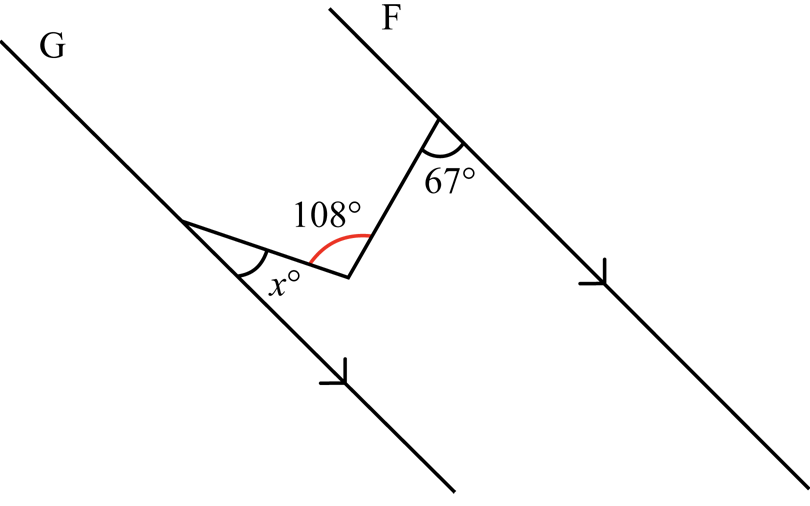In the diagram below, find the value of \(x^{\circ}\), giving reasons for your answer. (2 marks)
--- 4 WORK AREA LINES (style=lined) ---
Aussie Maths & Science Teachers: Save your time with SmarterEd
In the diagram below, find the value of \(x^{\circ}\), giving reasons for your answer. (2 marks)
--- 4 WORK AREA LINES (style=lined) ---
\(y^{\circ}\ =70^{\circ} \ \ \text{(alternate angles)} \)
\(x^{\circ}\ =z^{\circ} \ \ \text{(alternate angles)} \)
| \((z+y)^{\circ}\) | \(=110^{\circ}\ \) | |
| \((x+y)^{\circ}\) | \(=110^{\circ}\ \) | |
| \(x^{\circ}\) | \(=110-70\) | |
| \(=40^{\circ}\) |
\(\text{Extend middle parallel line:}\)
\(y^{\circ}\ =70^{\circ} \ \ \text{(alternate angles)} \)
\(x^{\circ}\ =z^{\circ} \ \ \text{(alternate angles)} \)
| \((z+y)^{\circ}\) | \(=110^{\circ}\ \) | |
| \((x+y)^{\circ}\) | \(=110^{\circ}\ \) | |
| \(x^{\circ}\) | \(=110-70\) | |
| \(=40^{\circ}\) |
In the diagram below, find the value of \(x^{\circ}\), giving reasons for your answer. (3 marks)
--- 6 WORK AREA LINES (style=lined) ---
\(\text{Full interior angle}\ = 360-275=85^{\circ} \ \ \text{(360° about a point)} \)
\(\text{Since cointerior angles sum to 180°,}\)
\(\Rightarrow \text{interior angle (1)}\ = 180-125=55^{\circ} \)
\(\text{Since angles about a point sum to 360°,}\)
\(\Rightarrow \text{interior angle (2)}\ = 85-55=30^{\circ} \)
| \(x^{\circ}\) | \(=180-30\ \ \text{(cointerior angles)} \) | |
| \(=150^{\circ}\) |
\(\text{Add parallel line:}\)
\(\text{Full interior angle}\ = 360-275=85^{\circ} \ \ \text{(360° about a point)} \)
\(\text{Since cointerior angles sum to 180°,}\)
\(\Rightarrow \text{interior angle (1)}\ = 180-125=55^{\circ} \)
\(\text{Since angles about a point sum to 360°,}\)
\(\Rightarrow \text{interior angle (2)}\ = 85-55=30^{\circ} \)
| \(x^{\circ}\) | \(=180-30\ \ \text{(cointerior angles)} \) | |
| \(=150^{\circ}\) |
In the diagram below, \(BC\) is parallel to \(DE\) and \(\angle ACB\) is a right-angle.
Find the value of \(x^{\circ}\), giving reasons for your answer. (3 marks)
--- 5 WORK AREA LINES (style=lined) ---
\(\text{Extend line}\ BC: \)
\(\angle GCF=180-120=60^{\circ}\ \ \text{(180° in a straight line)}\)
\(x^{\circ} = 60^{\circ} \ \ \text{(corresponding angles)}\)
\(\text{Extend line}\ BC: \)
\(\angle GCF=180-120=60^{\circ}\ \ \text{(180° in a straight line)}\)
\(x^{\circ} = 60^{\circ} \ \ \text{(corresponding angles)}\)
Find the value of \(x^{\circ}\) in the diagram, giving reasons for your answer. (3 marks)
--- 6 WORK AREA LINES (style=lined) ---
\(15°\)
\(\text{Extend the parallel line on the left:}\)
\(\text{Angle opposite}\ \angle ABC = 3x^{\circ}\ \ \text{(vertically opposite)}\)
\(\angle DEB = 360-(90+135) = 135^{\circ}\ \ \text{(360° about a point)} \)
| \(3x+135\) | \(=180\ \ \text{(cointerior angles)} \) | |
| \(3x\) | \(=180-135\) | |
| \(x^{\circ}\) | \(=\dfrac{45}{3}\) | |
| \(=15^{\circ}\) |
Find the value of \(x^{\circ}\) in the diagram, giving reasons for your answer. (3 marks)
\(50°\)
\(\text{Extend the middle parallel line:}\)
\(\text{Alternate angles are equal}\ (x^{\circ}) \).
\(\text{Cointerior angles sum to 180° (110° and 70°)}\)
\(x^{\circ} = 120-70=50^{\circ} \)
In the figure below, the lines `G` and `F` are parallel.

Determine the value of `x^@`. (3 marks)
--- 5 WORK AREA LINES (style=lined) ---
`41°`

| `x^@` | `= 108-67` |
| `= 41^@` |